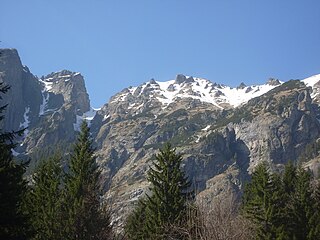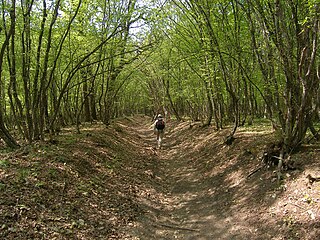 W
WBelasitsa Nature Park covers the northern slopes of Belasitsa Mountain in the Southwest Region of Bulgaria. The total area of the park is 117 km². Belasitsa is part of the European ecological network NATURA 2000 and is managed by the Belasitsa Nature Park Directorate which is a legal entity under the authority of the Executive Forest Agency of Ministry of Agriculture and Food. The Directorate office is located in the village of Kolarovo.
 W
WThe Bulgarka Natural Park is a Bulgarian nature park on the northern slopes of the Balkan Mountains, occupying 22,000 hectares of territory in the central and eastern part of the mountains between the cities of Gabrovo and Kazanluk.
 W
WGolden Sands Nature Park is a nature park on the Bulgarian Black Sea Coast in Varna Province. It is spread on an area of 13.2 square kilometres (5.1 sq mi). The park is 9.2 km (5.7 mi) long and on the average 1.2 km (0.75 mi) wide; it was declared a protected territory in 1943. According to the criteria of the World Conservation Union, it ranks fifth category on the list of protected territories.
 W
WPersina Nature Park is a wetland area along the Bulgarian side of the Danube that was established on December 4, 2000. Situated on the territory of three municipalities, it covers 21,762 ha. The designation of the park aims at conservation and restoration of Danube wetlands. Special attention is paid to the numerous islands and their natural status. The park is named after Persin Island, which is part of the Belene Islands Complex. It is 15 km (9.3 mi) long and 6 km (3.7 mi) wide, making it the fourth largest Danube island and the largest in Bulgaria. Another island group is located near Nikopol. Because of its uniqueness and high importance, the island group was proclaimed a Ramsar site on September 24, 2002. At 18,330 ha, it is the biggest such site in Bulgaria. The most significant ecosystems within the park are the flooded forests along the Danube and the inland marshes. In order to protect these habitats, several protected areas are established. A visitor centre for the park is located in Belene.
 W
WRila Monastery Nature Park is one of the largest nature parks in Bulgaria, spanning a territory of 252.535 km2 (97.504 sq mi) in the western part of the Rila mountain range at an altitude between 750 and 2,713 metres. It is in Rila Municipality, Kyustendil Province and includes forests, mountain meadows, alpine areas and 28 glacial lakes. With a little more than 1 million visitors, it is the second-most visited nature park in the country, after Vitosha Nature Park.
 W
WRusenski Lom Nature Park is a protected area in Ivanovo Municipality, Ruse Province, northern Bulgaria. The park was established on 26 February, 1970, in order to protect the canyon of the Rusenski Lom, the last significant right tributary of the Danube. The park covers an area of 3,408 hectares (13.16 sq mi).
 W
WThe Shumen Plateau Nature Park is located in the Shumen Plateau of the northern province of Shumen of Bulgaria, the highest plateau of the Danubian Plain. The Park encloses the Bukaka Reserve Forest, which is known for indigenous Fagus sylvatica Fagus sylvatica moesiaca forest. This Park was declared a National Park in 1980 and a Nature Park in 2003 to conserve its ecosystems and floral and faunal biodiversity, and to preserve its tableland landscape together with many tourist sites such as the Shumen fortress, the Monument to 1300 Years of Bulgaria, cave monasteries, and surface and underground karst caves. The park has the first thematic educational trail in the Karst Nature Park, constructed as part of a project titled "Natural Park of Shumen Plateau" with funds provided by the EU Cohesion Fund and the Republic of Bulgaria; the trail is integral to the Operational Program "Environment 2007–2013".
 W
WStrandzha Nature Park is the largest protected area in Bulgaria spanning a territory of 1,161 square kilometres (448 sq mi) in the Strandzha Mountain in the extreme south-eastern corner of the country on the border with Turkey. It was established on 25 January 1995 to protect ecosystems and biodiversity of European importance, as well as the traditional cultural, historical and folklore heritage of the region. The altitude varies from 710 metres (780 yd) on Gradishte Peak to 0 metres (0 yd) at the Black Sea coast with average length of 50 kilometres (31 mi) from west to east and 20 kilometres (12 mi) from north to south.
 W
WVitosha, the ancient Scomius or Scombrus, is a mountain massif, on the outskirts of Sofia, the capital of Bulgaria. Vitosha is one of the symbols of Sofia and the closest site for hiking, alpinism and skiing. Convenient bus lines and rope ways render the mountain easily accessible. Vitosha has the outlines of an enormous dome. The territory of the mountain includes Vitosha nature park that encompasses the best known and most frequently visited parts. The foothills of Vitosha shelter resort quarters of Sofia; Knyazhevo quarter has mineral springs. Vitosha is the oldest nature park in the Balkans. The mountain emerged as a result of volcanic activity and has been subsequently shaped by the slow folding of the granite rock layers and a series of gradual uplifts of the area. It appears dome shaped at first sight, but the mountain, 19 km long by 17 km wide, actually consists of concentric denudational plateaus rising in tiers one above the other. Vitosha is separated into four main parts whose main ridges gather at a crown known as Cherni Vrah. This is the highest point of the mountain at 2290 m and is one of 10 peaks of Vitosha over 2000 m in height. It is the highest massif of Srednogorie mountain chain system, together with Sredna gora, Plana (mountain), Lyulin Mountain, Greben (mountain), Viskyar Mountain, etc. They all are a result of the folding of the earth layers through the Mesozoic, causing also magma sheet-like intrusion that has been injected between layers of sedimentary rock. The lacolithic domed form of Vitosha is a typical example.
 W
WVrachanski Balkan Nature Park is a Nature Park in Bulgaria with an area of 30129.9 ha established on 21 December 1989.